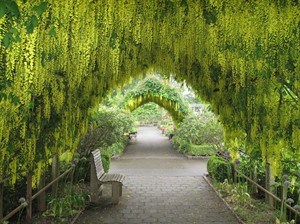
In this photo taken on May 21, 2012, a double arbor is framed by Laburnums at Bayview Farm & Garden as shown near Langley, W.A. (AP Photo/Dean Fosdick)
July 17, 2012 - 11:26 AM
Few plants adorn arbors or trellises as beautifully as flowering vines. They also can enhance the landscape with fragrance, provide shade and screen unsightly views.
But be careful which varieties you choose. Some vines can be thugs.
Vines are vigorous growers, which can be both good and bad for impatient gardeners. Fast-growing varieties provide thick barriers that screen well-tended yards from unpleasant backdrops. But they also might overwhelm narrow planting beds and spread beyond their intended sites. That means constant monitoring and frequent pruning.
"There's nothing like vines for softening garden fixtures," said Bob Polomski, a horticulturist and arborist at Clemson University in Clemson, S.C. "Most are perennials and come back every year, heavy with blooms. They also provide a cooling shade, which is especially welcome in the South."
At the same time, he said, "being rapid (in growth) is one thing. Being invasive is another."
He cited English ivy, which has overwhelmed so many areas in the nation's East and Northwest that college students and other work parties frequently hold "plant pulls" to help control it.
"Ivy can take over as a ground cover," he said. "Wisteria can grow so quickly and its vines become so thick that it can destroy a small apparatus" such as a trellis, pergola, etc. "They get so heavy that they can even take down trees."
Knowing where to place vines is critical, Polomski said.
"Wisteria produces beautiful blooms, but that attracts bees. Putting chairs and tables beneath a flowering arbour can invite stings and creepy crawly things," he said. "Putting vines around mailboxes may not be such a great idea for mail carriers, either - especially when you have all those pollinators flying around."
None of which should discourage property owners from adding vines to their landscape. They simply need to plan first.
Vines climb in different ways, which may help determine which variety to choose: clinging, twining or sprawling.
Clinging vines, such as Virginia creeper, trumpet vines and ivy, have adhesive tendrils or rootlets that hold them to flat surfaces as they grow. That can make them difficult and even damaging to remove if the vines are attached to shingles or wood siding.
"The aerial roots on some clinging vines will work their way into chinks in walls and stucco and slowly compromise the structure," said Sydney Park Brown, an extension horticulturist with the University of Florida.
Twining vines, such as clematis, jasmine, wisteria and morning glories, spiral upward, looping around poles, latticework or fences.
Roses, bougainvillea and sweet peas are sprawling plants that often must be tied to a trellis, especially when getting started.
A few things to consider when adding plant supports:
— Give vines space to breathe to prevent mould and decay. Set freestanding trellises a few inches away from structures.
— Opt for strength and size when setting up an arbour, trellis or pergola. Vines can live for decades and grow heavy with age.
— Place scented varieties near doors and windows to better enjoy the fragrance.
— Look for seed- or fruit-producing vines to attract more wildlife to your yard.
___
Online:
For more about the care and feeding of flowering vines, see this Purdue University Cooperative Extension Fact Sheet: http://www.hort.purdue.edu/ext/HO-21.pdf .
You can contact Dean Fosdick at deanfosdick(at)netscape.net
News from © The Associated Press, 2012